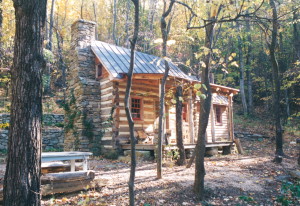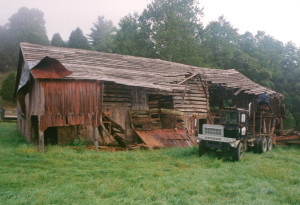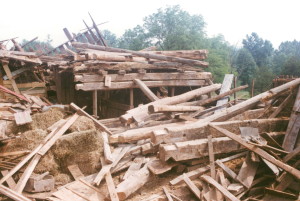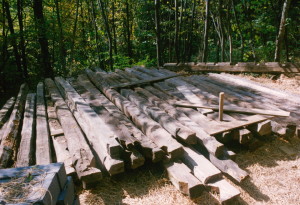This little log cabin garnered a surprising amount of attention over the weekend. It seems that there are more than a few people that would love to have a special place like this for a retreat.
I thought I’d show everybody the process of building one of these, from beginning to end. I think you will find it entertaining, as well as educational.
As always, I thank you for letting me share.
The first step in building a cabin is that we need to acquire the logs. There is little sense in designing a cabin until we have an inventory of logs. So the hunt begins. Travel the back roads, read the rural papers, contact salvage companies, even look on eBay. We want the best logs we can find.
This cabin’s logs came from an old barn who’s roofing had blown off, The barn was in the process of falling down which was creating dangerous conditions for people and cattle alike. So, it had to come down.
Better to be re-purposed than lost.
This barn was a “double-pen barn” which is two cabins built close together with a single roof spanning both structures. One of these log sections was used for our cabin project here, and the other went to another project that I built at the same time (it was a log cabin addition off of an old farmhouse).
The logs were oak, my favorite cabin material. Heavy, solid, beautiful, and naturally resistant to rot and insects.
Now taking down a cabin in this bad of a condition is a scary, dirty, dangerous business. We chose to use a logger friend of ours who has the skills with a lift that a doctor has with his hands. The site appeared to be a disaster when he finished but not a scratch could be found on a single log and it was much safer for us to go in and extract the logs without the danger of collapse. He was proud of what he accomplished. And, I was thankful.
The final photo shown here is of the logs carefully stacked at the site.
Logs that come from barns are different than those from a log house. On the positive side they tend to be more massive in size and thickness, their hewing marks are more pronounced and pleasing to the eye, and they don’t have any damage from the finishing details of a home such as plaster marks, or electrical wire holes.
Another plus with barn logs is that barns have few openings cut into them, this allows us to pick and choose where windows and doors go. It’s a lot easier to add a window to a cabin, than erase one.
The only downside to a log barn vs. log house is the quality of the workmanship of the original builders… they didn’t care nearly as much if the joinery was well done, or if the building was level or plumb… so we often, as in this case, have to re-notch the corners.
You may ask “why would a man build his log home better than his barn?” I would think that the answer would likely be that his wife expected a higher level of finish than his cow. 🙂
See Part Two of this series in the Log Cabin section of this site…
Originally posted 2015-02-16 20:08:56.




